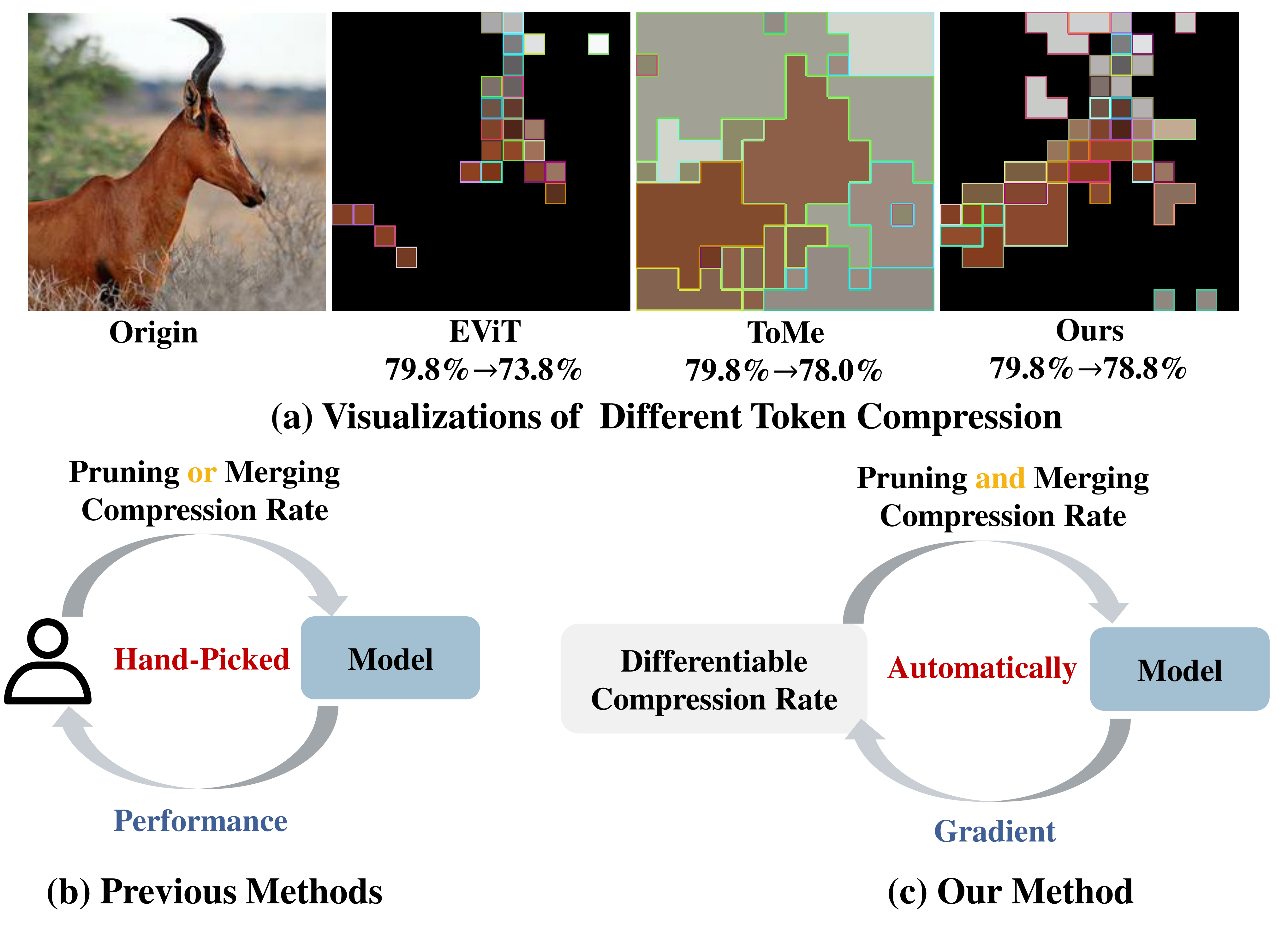This a official Pytorch implementation of our paper "DiffRate : Differentiable Compression Rate for Efficient Vision Transformers"
 Previous methods typically focus on either pruning or merging tokens using hand-picked compression rate with the guidance of performance. But DiffRate can leverages both approaches simultaneously to achieve more effective compression using the differentiable compression rate with gradient optimization.
Previous methods typically focus on either pruning or merging tokens using hand-picked compression rate with the guidance of performance. But DiffRate can leverages both approaches simultaneously to achieve more effective compression using the differentiable compression rate with gradient optimization.
- python >= 3.8
- pytorch >= 1.12.1 # For scatter_reduce
- torchvision # With matching version for your pytorch install
- timm == 0.4.5 # Might work on other versions, but this is what we tested
- jupyter # For example notebooks
- scipy # For visualization and sometimes torchvision requires it
- termcolor # For logging with color
- The ImageNet dataset should be prepared as follows:
ImageNet
├── train
│ ├── folder 1 (class 1)
│ ├── folder 2 (class 2)
│ ├── ...
├── val
│ ├── folder 1 (class 1)
│ ├── folder 2 (class 2)
│ ├── ...
Our proposed DiffRate is designed to operate utilizing the officially endorsed pre-trained models of MAE and DeiT. To facilitate seamless integration, our code is programmed to automatically download and load these pre-trained models. However, users who prefer manual downloads can acquire the pre-trained MAE models via this link, and the pre-trained DeiT models through this link.
We provide the discovered compression rates in the compression_rate.json file. To evaluate these rates, utilize the --load_compression_rate option, which will load the appropriate compression rate from compression_rate.json based on the specified model and target_flops.
DeiT-S
For the ViT-S (DeiT) model, we currently offer support for the --target_flops option with {2.3,2.5,2.7,2.9,3.1}. To illustrate, an example evaluating the ViT-S (DeiT) model with 2.9G FLOPs would be:
python main.py --eval --load_compression_rate --data-path $path_to_imagenet$ --model vit_deit_small_patch16_224 --target_flops 2.9
This should give:
Acc@1 79.538 Acc@5 94.828 loss 0.902 flops 2.905
DeiT-B
For the ViT-B (DeiT) model, we currently offer support for the --target_flops option with {8.7,10.0,10.4,11.5,12.5}. To illustrate, an example evaluating the ViT-B (DeiT) model with 11.5G FLOPs would be:
python main.py --eval --load_compression_rate --data-path $path_to_imagenet$ --model vit_deit_base_patch16_224 --target_flops 11.5
This should give:
Acc@1 81.498 Acc@5 95.404 loss 0.861 flops 11.517
ViT-B (MAE)
For the ViT-B (MAE) model, we currently offer support for the --target_flops option with {8.7,10.0,10.4,11.5}. To illustrate, an example evaluating the ViT-B (MAE) model with 11.5G FLOPs would be:
python main.py --eval --load_compression_rate --data-path $path_to_imagenet$ --model vit_base_patch16_mae --target_flops 11.5
This should give:
Acc@1 82.864 Acc@5 96.148 loss 0.794 flops 11.517
ViT-L (MAE)
For the ViT-L (MAE) model, we currently offer support for the --target_flops option with {31.0,34.7,38.5,42.3,46.1}. To illustrate, an example evaluating the ViT-L (MAE) model with 42.3G FLOPs would be:
python main.py --eval --load_compression_rate --data-path $path_to_imagenet$ --model vit_large_patch16_mae --target_flops 42.3
This should give:
Acc@1 85.658 Acc@5 97.442 loss 0.683 flops 42.290
ViT-H (MAE)
For the ViT-H (MAE) model, we currently offer support for the --target_flops option with {83.7,93.2,103.4,124.5}. To illustrate, an example evaluating the ViT-H (MAE) model with 103.4G FLOPs would be:
python main.py --eval --load_compression_rate --data-path $path_to_imagenet$ --model vit_huge_patch14_mae --target_flops 103.4
This should give:
Acc@1 86.664 Acc@5 97.894 loss 0.602 flops 103.337
CAFormer-S36
For the CAFormer-S36 model, we currently offer support for the --target_flops option with {5.2,5.6,6.0}. To illustrate, an example evaluating the CAFormer-S36 model with 5.6 FLOPs would be:
python main.py --eval --load_compression_rate --data-path $path_to_imagenet$ --model caformer_s36 --target_flops 5.6
This should give:
Acc@1 83.910 Acc@5 96.710 loss 0.712 flops 5.604
To find the optimal compression rate by proposed DiffRate, run the following code:
python -m torch.distributed.launch \
--nproc_per_node=4 --use_env \
--master_port 29513 main.py \
--arch-lr 0.01 --arch-min-lr 0.001 \
--epoch 3 --batch-size 256 \
--data-path $path_to_imagenet$ \
--output_dir $path_to_save_log$ \
--model $model_name$ \
--target_flops $target_flops$
- supported
$model_name$:{vit_deit_tiny_patch16_224,vit_deit_small_patch16_224,vit_deit_base_patch16_224,vit_base_patch16_mae,vit_large_patch16_mae,vit_huge_patch14_mae,caformer_s36} - supported
$target_flops$: a floating point number
For example, search a 2.9G compression rate schedule for ViT-S (DeiT):
python -m torch.distributed.launch \
--nproc_per_node=4 --use_env \
--master_port 29513 main.py \
--arch-lr 0.01 --arch-min-lr 0.001 \
--epoch 3 --batch-size 256 \
--data-path $path_to_imagenet$ \
--output_dir $path_to_save_log$ \
--model vit_deit_small_patch16_224 \
--target_flops 2.9
See visualization.ipynb for more details.
If you use DiffRate or this repository in your work, please cite:
@article{DiffRate,
title={DiffRate : Differentiable Compression Rate for Efficient Vision Transformers},
author={Mengzhao Chen, Wenqi Shao, Peng Xu, Mingbao Lin, Kaipeng Zhang, Fei Chao, Rongrong Ji, Yu Qiao, Ping Luo},
journal={arXiv preprint arXiv:2305.17997},
year={2023}
}
This codebase borrow some code from DeiT and ToMe. Thanks for their wonderful work.